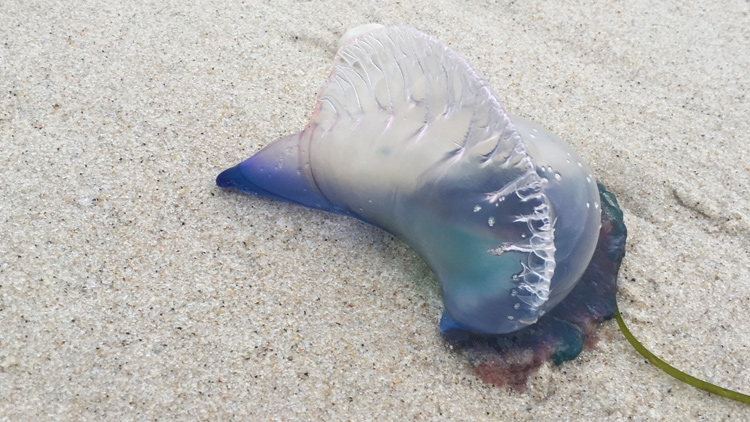More than a dozen rare sightings of venomous Portuguese Man-O-War on Long Island beaches have surfaced since the jellyfish-like creature stung two boys on Fire Island this week, officials and eyewitnesses said.
At least 18 have been spotted from Jones Beach State Park to Montauk and many ocean beaches in between. That number may rise this weekend when beachgoers flock to the shore in what is forecast as the first fully rain-free weekend of summer.
“Beachgoers should be vigilant,” said John Stewart, chief law enforcement ranger of the Fire Island National Seashore (FINS). “If visitors observe a Portuguese Man O’ War…they should alert lifeguards, park rangers or law enforcement officers.”
Aside from the two man-o-wars that stung two children Tuesday in Kismet and Davis Park, FINS officials said one was also spotted in Fire Island Pines and four more were found in Sailor’s Haven. Lifeguards buried those in the sand.
New York State parks officials confirmed that two more were found in Montauk area state parks, one was found at Robert Moses State Park and one was found at Jones Beach on Thursday, a day after FINS officials said a visitor three more at Jones Beach.
The Long Island Coastal Conservation Research Alliance (LICCRA), a nonprofit environmental group, confirmed some of those sighting and said another was found at Tiana Beach in Hampton Bays.
And a reader who emailed the Press with a photo of a man-o-war she said that she found on the beach in Bridgehampton on Thursday added that she also saw two more on the beach in Wainscott.
“If you do see them in the water you do want to give them a really wide birth,” says Joe Yaiullo, curator/co-founder of Long Island Aquarium in Riverhead. “They’re pretty much going to go wherever the wind or currents take them.”
RELATED STORY: 6 Hazards to Beware of at Long Island Beaches This Summer
Portuguese Man-O-War sightings in local waters are unusual since they are usually found in warmer waters in the Caribbean, Pacific and Indian oceans. The last reports of Portuguese Man-O-War washing ashore on Long Island was two years ago in the Hamptons.
The creatures are technically a floating colony of organisms that form a pink or purple gas-filled pouch that sails on the surface of the water with numerous tentacles that can grow up to 30-feet or longer, according to the National Oceanic and Atmospheric Administration (NOAA).
Aside from an intense, painful sting, contact with its tentacles can also result in welting and blistering, NOAA said. In rare cases, its sting has reportedly proven deadly.
If stung, swimmers should rinse the affected area with salt water and vinegar, FINS and Suffolk County health officials said. If a severe reaction occurs, seek immediate medical attention.
“Running hot water, as hot as you can take it for 10 or 15 minutes, that will break down a lot of the toxins,” Yaiullo said, adding that he’s heard “mixed results” about using vinegar. “When you look at some of these people who’ve been stung, it almost looks like they’ve been whipped.
Yaiullo and LICCRA warned that the man-o-war can still inflict their painful sting even after they’re dead.
–With Timothy Bolger

































